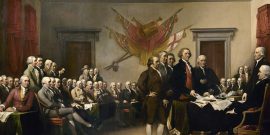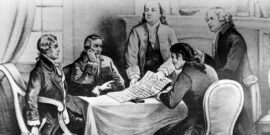Not so long ago, statesmen delivered speeches to reforge a sense of national identity by invoking the principles of the Declaration of Independence.
The Declaration's Principles of Politics
Last year I penned an analysis and something of a paean to the Declaration of Independence. Perhaps a follow-up is in order. Who knows, perhaps it could become a fourth of July tradition? Certainly there is a good deal more in the famous text than one entry could survey. In fact, the general purpose of this one is to provide material for reflection. That would be a thoughtful way of being patriotic on this day of commemoration and celebration.
The Declaration applies various sorts of principles – theological; anthropological; and political – to a set of “Facts” – chiefly “injuries and usurpations” on the part of the British monarch (and, belatedly, Parliament). It judges the facts as evincing a design of tyranny, and concludes, as it began, with the necessity and duty of revolution and independence, understood as self-government by and for free men and women.With quite recent events in mind, perhaps it is fitting to look at some of what I style “the principles of politics” enunciated in the document. They can be found in three distinct parts of the text: the statement of principles that begins “We hold these truths to be self-evident”; in the list of twenty seven “injuries and usurpations” that forms the third part of the text; and in the final part, where the colonies declare themselves to be de facto and de jure “Free and Independent States”, and some of their important “Power[s]” as states are enumerated.
Each part provides important statements concerning the principles of politics, the ends and means, necessary and/or desirable, of political activity, especially in the formation of government. The first introduces the important term “principles”; the list of grievances indicates the right order of government and governmental action by indicting the negative actions of the King and Parliament: “injuries” means a violation (“in-“) of what is right or just (“jus/juris”); while “usurpations” implies authority transgressing rightful limits. The last section picks up the introduction of “the State” in the third part, as well as the affirmation that government is essentially a matter of organized “powers” in the second section, and lists four powers that states possess, adding to those previously indicated.
In good teleological fashion, it is proper, even necessary, to begin with the Declaration’s express statements of the purposes of government. Everyone, so to speak, knows that the Declaration maintains that, in its normative view, “Governments are instituted” “to secure these rights” [that is, “unalienable rights,” “Creator”-endowed rights, “among which are life, liberty, and the pursuit of happiness”]. But attention is hardly ever given to a closely following statement: “whenever any Form of Government becomes destructive of these ends [the aforementioned unalienable rights], it is the Right of the People to alter or abolish it, and to institute new Government, laying its foundation on such principles and organizing its powers in such form, as to them shall seem most likely to effect their Safety and Happiness.” Here is a different statement of governmental purpose, one that envisages the People as such, as a whole, and not just discrete individuals and their rights, even taken collectively. Moreover, the end of government is now two-fold.
Two comments: 1) the phrase “Safety and Happiness” appears to indicate the alpha and the omega of collective existence, its pediment in safety or security, and a people’s ultimate aspirations toward collective fulfillment and achievement. That these two are not the same, that they do not always cohere, that they are left open for determination, render them intrinsically questionable and permanently debatable. Americans, both in government and without, will always have these goals to clarify and decisions concerning their content and relations to make.
2) This complexity or ambiguity is only increased when one recalls the original statement of governmental purpose, the protection or security of unalienable rights. It did not take recent NSA debates to know that individual rights and public safety can be in tension, nor much imagination to come up with tensions, real or claimed, between visions or projects of collective betterment and individual rights.
In brief, the goals of government recognized by the Declaration set up a system in which a never-ending debate will take place between, let’s say, a more liberal or libertarian emphasis on individual rights and a more democratic accent on popular or collective ends. It would be interesting, perhaps illuminating, to survey American political history in this optic. Be that as it may, the goals of government according to the Declaration are complex, not simple (nor straight-forward), and it is reductionist to simply affirm the rights-protection purpose, although it was first and is essential. Nor for that matter should collective goals, whether low and solid or high and enriching, be proposed or pursued without consideration of individual, and individuals’, rights. With deliberate paradox, one could call this the first American debatable consensus. There are others, and the Declaration limns them as well.
Government, we were told above, is a matter of principles and powers, foundation and form – eventuating in a Form. Again, some elementary commentary. In this view, government is a human construct, with intelligence laying its “foundation” on yet deeper “principles,” then thoughtfully “organizing” its “just powers,” the whole forming a structure that can effectively pursue the ends for which it is formed, while guarding against the great temptation of power, tyranny. (Incompetence does not seem to be a concern.) The most basic powers appear clearly in the section devoted to English misdeeds; they are the well-known legislative, executive, and judicial powers of classical liberalism. And many principles of the construction of government are stated or implied throughout: the subordination of military to civilian authority is one; the independence of the judiciary another. The primacy of the legislative power and of legislation is indicated by their precedence in the bill of indictments.
Thus, the Declaration limns what we could call a political science of government, that is, of the just and artful construction of government. (The distinction between political philosophy and political science I employ is found in Locke.) This does not mean that all questions of governmental formation are addressed, much less answered by the document. The fact that the same Congress that ratified the Declaration also approved the Articles of Confederation would indicate that there was still considerable reflection to be done in this regard, including the meaning and application of principles already accepted.
Still, a basic point remains: the American mind which produced and ratified the Declaration believed that government could be thought about in a principled (i.e., non-partisan) way, and that the fundamental distinction between tyrannical and free government was accessible to those who grasped the relevant principles of its construction and operation and could judge facts in their light. A reconsideration and revivification of that belief would be a worthy goal and result of today’s commemoration.


